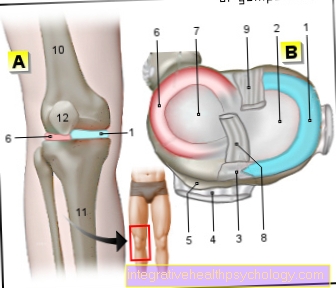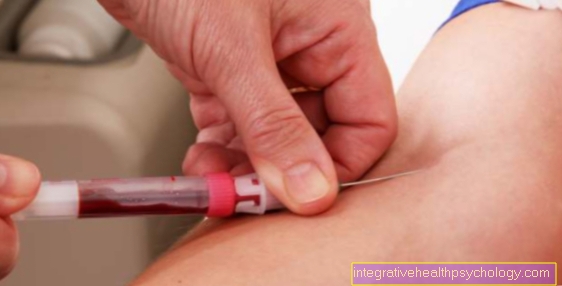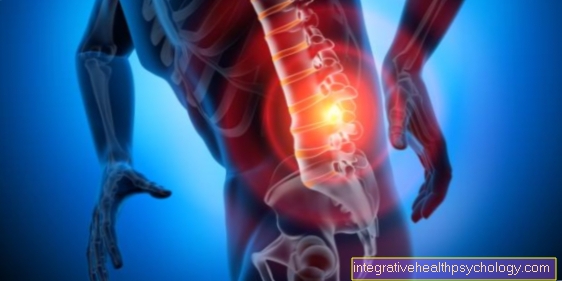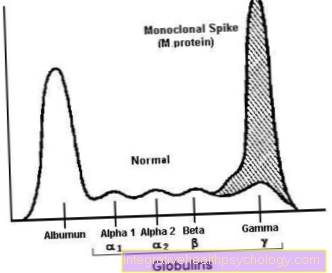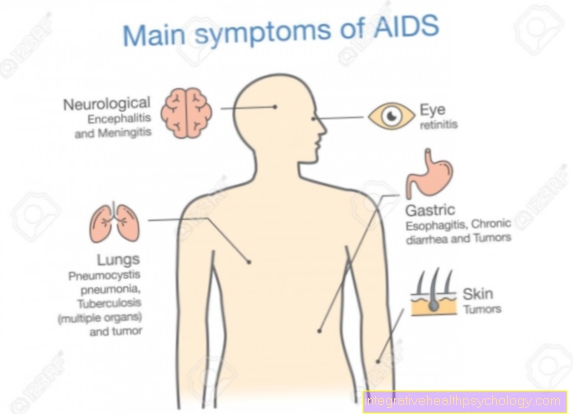Taping of a patellar tip syndrome
definition
As Patellar tip syndrome describes a chronic disease of the bone-tendon junction on the kneecap (patella). This is a very painful overload condition. It often occurs as a result of constant stress in the form of pulling in the context of regularly practiced sports such as volleyball, basketball, high jump, long jump or jogging. Furthermore, reduced elasticity and general weakness of the ligaments of the knee also play an important role in the development of the syndrome.

effect
The Kinesio tapes have increasingly played an important role in the treatment of sports disorders. The tapes are elastic and, for therapeutic purposes, stretchable adhesive strips. They are attached to the joints and muscles using a special technique. You will be a distinct one Decrease in pain and a Accelerating the healing process awarded. They are also often used for patellar tip syndrome.
There they unfold their effectiveness by relieving the tensile load on the tendons, whereby the pain and at the same time the wear and tear of the bony structures are reduced. The tape supports the joint in movement and reduces the stress on the surrounding tissue. In addition, the tape should also have a positive effect on blood circulation to have. Through better microcirculation and lymph drainage, joints, tendons and muscles are better supplied with blood and the healing process is positively supported.
manual
For taping the kneecap (patella) the patient needs two different tape strips. One tape should be in the shape of a "Y", the other should be a little shorter and a simple strip. You get these tapes pre-made or you can cut them yourself. If the tapes are cut to size yourself, the Y-shaped strip should have a base of approx. 3-4 cm. The corners can be rounded so that the strips stick better to the skin. Before the tape is applied to the skin, it should first be cleaned. Oil, creams and hair should be removed so that the tape adheres better and removal is not uncomfortable later.
To attach the tape strips in the correct position, the Position of the knee very important. The correct position of the tape is important so that it can have any effect on the tendon. The knee should therefore be bent to about 80 degrees. So you have an optimal position for the application and in the event that the patient applies the tape himself, he has a good view of the knee.
After the strips have been cut to the correct width and length, the release liner can be removed. Start with the Y-shaped strip. The patient first looks for the Patellar tendon on. This is located as a solid, palpable structure directly below the kneecap.

I would be happy to advise you!
Who am I?
My name is dr. Nicolas Gumpert. I am a specialist in orthopedics and the founder of .
Various television programs and print media report regularly about my work. On HR television you can see me every 6 weeks live on "Hallo Hessen".
But now enough is indicated ;-)
The knee joint is one of the joints with the greatest stress.
Therefore, the treatment of the knee joint (e.g. meniscus tear, cartilage damage, cruciate ligament damage, runner's knee, etc.) requires a lot of experience.
I treat a wide variety of knee diseases in a conservative way.
The aim of any treatment is treatment without surgery.
Which therapy achieves the best results in the long term can only be determined after looking at all of the information (Examination, X-ray, ultrasound, MRI, etc.) be assessed.
You can find me in:
- Lumedis - your orthopedic surgeon
Kaiserstrasse 14
60311 Frankfurt am Main
Directly to the online appointment arrangement
Unfortunately, it is currently only possible to make an appointment with private health insurers. I hope for your understanding!
Further information about myself can be found at Dr. Nicolas Gumpert
The broad base of the strip should now be attached a little below the tendon. The split into the two laterally running stripes should therefore be exactly on the tendon. Only with the correct placement of the tape can the pain be relieved later. Then the outgoing strips are glued on. These are affixed to the left and right in a C-shape around the kneecap with maximum tension. The tape is pressed down well.
It should be noted that the ends of the tape are attached again without tension or tension. The ends can slightly overlap.
Now the second prepared tape is attached. The I-shaped tape is first torn in the middle, leaving a small gap. This tape strip is now attached directly to the patellar tendon with maximum tension. There is then an additional relief of the tendon so that the pain should decrease significantly, especially when moving. To check whether the tape has been correctly applied, the patient can now extend his knee. As a rule, the tapes should now fold regularly.
Furthermore, it can be ensured that the tapes adhere well in all places and do not loosen. The tapes should support movement in the knee joint but not block it. Pulling too hard that feels uncomfortable in the joint can be counterproductive and not have the desired effect. In most cases, the best and desired effect occurs in the first three to five days after the tape dressing has been applied. It should be worn for a week and can be worn for everyday things such as showering and exercising despite sweating. The tape strips usually do not loosen even when swimming.
If after a few days or hours skin irritation shows up and the skin under and around the tape begins to itch, a intolerance exist against the materials of the tape. It should then be removed again.
If the patient is unsure how to apply the tape independently, he can get help from a doctor or physiotherapist. It also makes sense to have a Patellar tip syndrome not to be treated only with the help of tapes. Regular physiotherapy under the guidance of a physiotherapist helps to strengthen the muscles in the knee and thus also to protect the tendons from overload.





